1885 Season
Nov 29 Local ice formed Bonne Bay. (GR p.85)
Dec 20 Slob drifting out of Little Harbour Island. (GR p.94)
Dec 24 Local ice formed Bay of Islands. (GR p.88)
Dec 29 The “Princess of Wales” reached her winter berth this afternoon. She smashed through ten inches of ice as if it was eggshells. (Pat 29 Dec p3#1)
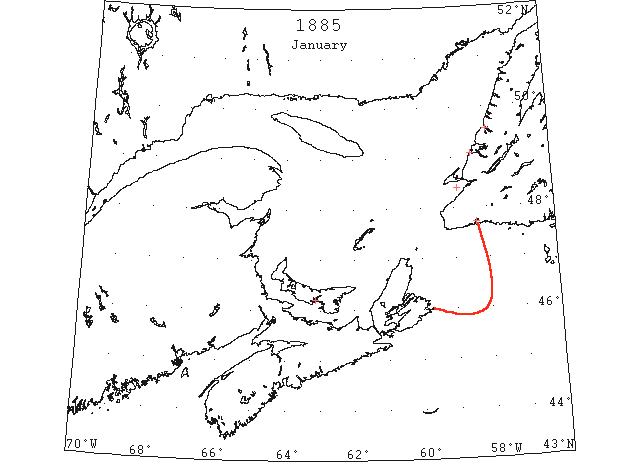
Jan 9 The ice now affords good crossing. (Pat 9 Jan p3#2)
Jan 13 Georgetown harbour is quite clear of ice, and the ferry boat is running from there to Lower Montague regularly. (Pat 13 Jan p3#1)
Jan 14 Local ice formed St. George’s Bay. (GR p.91)
Jan 17 Gulf ice first arrived La Poile; in and out till March 29. (GR p.92)
Jan 20 Northern ice arrived Bonne Bay. (GR p.85)
Jan 28 Northern ice arrived Bay of Islands. (GR p.88)
Jan 28 Gulf ice arrived St. George’s Bay. (GR p.91)
Jan 29 Gulf ice out La Poile. (GR p.92)
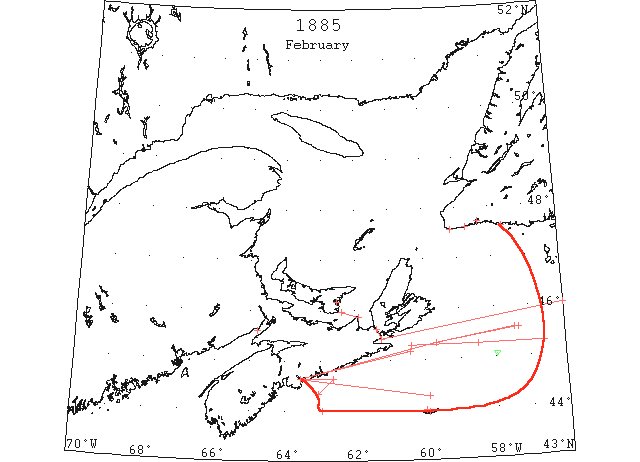
Feb 2 Bark “St. Olaves”- Saint John, NB- There is a bark in the ice and in a dangerous position off Cape Enrage, supposed the “St. Olaves” (Br), which sailed from this port Jan 27th for Liverpool. (NYMR 4 Feb p.3, col.2).
Feb 3 Gulf ice arrived Burgeo. (GR p.94)
Feb 4 Issue: Ice is drifting out of Gulf as far north [south?] as 44°. (NYMR)
Feb 5 The “Northern Light” arrived at Georgetown last evening. The “Northern Light” left Pictou on Thursday morning last. She proceeded all right, although it was with difficulty that passages could be found through the large quantities of ice in the gulf, until she arrived within four miles of Cape Bear, where she stuck fast in the ice and could not proceed further. It was then blowing a gale from the northwest, with snow and drift. The storm rendered it impossible to see far in any direction, and the steamer having stopped, was soon driven with the ice to the vicinity of Cape George, where she remained until Monday night. The captain then discovered a break in the ice which he hoped would enable him to bring the steamer to open water; but after steaming up and following that lead for about two or three miles, and finding it was leading the vessel too much to the eastward, he deemed it best to stop her until daybreak. At daybreak Tuesday morning all were astir, steam was go up and an attempt was made to force a passage through the solid field of ice, which was between seven and nine inches thick, and extended as far in every direction as he eye could reach. It was blowing a severe gale, freezing hard, and the drifting snow prevented seeing for ahead. Finding it too slow work to lie battering at the ice with the stem of the boat the stern was tried, and, strange to say, she steadily proceeded stern first for between fifteen and eighteen miles at the rate of about two and a half miles an hour, being steered by the hoisting and lowering of the jib, as she required. At last open water was seen, and the hearts of the passengers and crew were cheered. Along the steamer went until she reached open water, when she was put bow on, and steered on the proper course for Georgetown harbor. It was soon found, however, that a large quantity of very heavy ice prevented her following that course, which course, after trying in vain to force a passage through the ice, was abandoned, and the ship was steamed along the northern extremity of it, and was then steered direct for Georgetown harbor, which in due time hove in sight and was reached about seven o’clock in the evening. (MH 05/02/1885 p5 #2)
Feb 5-6 The mail steamer ”Newfoundland,”, arrived Saturday night from St. John’s, N.F; reports left and steamed through slob ice to Cape Ray, encountering a strong head wind and sea, until evening of the fifth. That night at 9:45, the steamer entered heavy ice in 45°35’N 57°25’W. At 8 a.m. of the 6th, the ice jammed heavily, and hemmed the ship in. Her engines were stopped, and during the night, the wind blew a terrific gale from the east, with thick snow. A heavy south east swell began to heave in under the ice, and at daylight, all available sail was made, the engines started, the ship being forced out. At 4 p.m. the steamer left the heavy ice in 45°20’N 59°40’W having forced her way through 100 miles of it. Slob ice was then met with all the way to Halifax harbor. Capt. Mylius states the ice encountered was the heaviest he ever saw this time of the year, some of it being 15 feet thick. (MH 09/02/1885 p3#3)
Feb 6 Gulf ice in again La Poile (local ice formed Feb. 5). (GR p.92)
Feb 7 SS “Newfoundland” at Halifax, 45°20’N 59°40’W very heavy field ice. (NYMR)
Feb 9 The steamer “Miranda,” arrived on Saturday evening from St. John’s, Nfld. She left that port on Thursday morning, at eight o’clock, encountering a heavy north-east gale that night, with snow and a south-easter, with snow on Friday, and passed twenty miles north of Sable Island. The steamer passed through slob ice all the way, and was off this port [Halifax] on Saturday morning. (MH 09/02/1885 p3 #1)
Feb 10 Bark “St. Olaves” after being in the ice several days off Cape Enrage returned to St. John, NB having sustained damage. (MWR).
Feb 14 SS “Serpio” 44°N 62°55’W passed field ice. (MWR).
Feb 14 Gulf ice out again La Poile. (GR p.92)
Feb 15 Gulf ice in again La Poile. (GR p.92)
Feb 15 Halifax, arrived, steamer “Caspian” from Liverpool, GB. 15th had a heavy NE snow storm, and passed through 40 miles of ice to Halifax. Steamer “Toronto” from Liverpool, GB, on the 15th in the afternoon, had a strong gale from NE with snow which moderated at midnight. When within 40 miles of Halifax encountered field ice, and steered SW 25 miles to clear it. (MH 17/02/1885 3 #6)
Feb 16 The Furness Liner “Ripon City” arrived Halifax. left the ice in 45°N 43°30’[?]W, about 650 miles east of Halifax, and made for this port, passing vast quantities of ice on the way. The north side of Sable Island was jammed with ice. (MH 17/02/1885 p3 #3)
Feb 19 Gulf ice arrived Burgeo. (GR p.94)
Feb 21 SS “Saint Germain” passed an iceberg 45°4’N 57°58’W. (MWR Feb.35.2)
Feb 22 Gulf ice out again La Poile. (GR p.92)
Feb 23 Letter from Capt. of Mail Steamer “Newfoundland”: The ice north of Sable Is. which comes out of the Gulf of St. Lawrence extends at present nearly from the Banks of St. Peters to past the Straits of Canso and northward into the gulf. On the previous voyage we passed through over 100m of very heavy ice from 45°35’N 57°20’W to 45°20’N 59°40’W and we were jammed in it for 20 hours. This voyage I took a more southerly course and keeping south of 45°17’N I passed through the southern edge of the ice running through about 80m each way. I have not, during the 12 winters I have run mails to Newfoundland found such heavy ice so early in the localities mentioned until this season. The temperature of the water seems to be lower this spring than in many former years and the ocean seems to be one congealed mass. The Banks, south of Newfoundland and towards the coast of Nova Scotia, are full of what we term slot [sic] ice, and the sea from Cape Race to Belle Isle is full of heavy ice and icebergs. I was this time detained 2 days, 12 hours through the ice blockade on the coast, and according to all accounts from incoming Dundee sealing steamers and other observations, I firmly believe this will be a trying spring for ocean steamers and vessels in the north Atlantic trade. It has been reported to me by the above mentioned sealing steamers that the icebergs were uncountable. Charles Mylius. (MWR)
Feb 23 Halifax, arrived, steamer “Newfoundland” from St. John’s, NF, reports passed along the southern edge of heavy Gulf ice for 70 miles, and slob ice from Canso Bank to port. (MH 23/02/1885 p3 #6)
Feb 23 The schooner “Tyrone” from Boston for St. Pierre, Miq., via Lunenburg; which arrived at this port [Halifax], put into Lunenburg and had been in the ice. (MH 23/02/1885 p3 #1)
Feb 25 Arrived at Gloucester, Mass., Feb 25, schr “Festins” reports being in ice off Sable Island thirty six hours, but received no damage. (MH 28/02/1885 p3 #5)
Feb 26 Gulf ice departed Burgeo. (GR p.94)
Feb 27 Channel and Rose Blanche packed. (GR p.32)
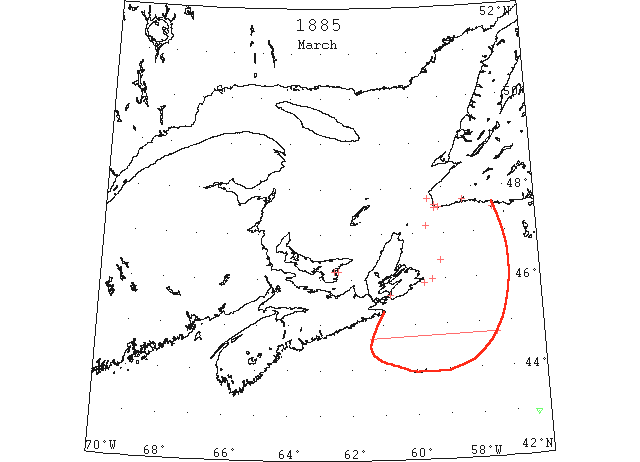
Mar ? From E of the Banks to Sable Is. a number of large bergs and drift ice. (NYMR)
Mar 1-29 The S.S. “George Shattuck” sailed from this port March 1st, and arrived at Port au Basque March 5th having passed through immense quantities of field ice. Sailed March 10th for the gulf. At 3 p.m., the same day 12 miles north-west from Cape Ray very heavy ice was met with. It was found impossible for any of the steamers to force themselves through the ice, and all remained jammed with in a few miles of each other. About noon the following day the ice opened in small cakes for a short time, and the “Shattuck” succeeded in forcing a few miles to the westward, and became completely jammed. A this time the ship was only a short distance from the school of old hood seals, and quite a number were shot as they came up to breathe in the small openings in the ice. The ship remained jammed until the night of the 14th, when a severe gale caused a sudden movement of the ice and she was caught between two heavy floes and the rudder and rudder post completely torn away. She remained jammed until March 29th when she succeeded in getting clear of the ice and returned to Port au Basque. Capt. Farquharson [sic] came to Halifax, had a new rudder made, and with divers returned to the ship last week. The new rudder was successfully secured to the steamer, and the “Shattuck” sailed for Halifax. When 35 miles north-east off Scaterie [sic], a steamer was seen, apparently in loose ice, but no signal was showing for assistance. Many sailing ships were seen coursing about in the loose ice, thirty miles SSW from Cape Ray. Some of the old seal hunters on the west coast of Newfoundland say the present spring is the worst known in the gulf for twenty-five years. Heavy ice was met with off the south coast of Cape Breton, west of Louisburg. (MH 11/05 [04?]/1885 p3 #3)
Mar 2 Gulf ice in again La Poile. (GR p.92)
Mar 4 The steamer “St. Pierre,” arrived [Halifax] last night from St. Pierre, Miq., via Salmon River, NS. The steamer got into heavy ice on Saturday night off the coast, broke three blades of her propeller, had one whole one remaining, got into Salmon River. (MH 04/03/1885 p3 #1)
Mar 5 42°56’N 56°23’W a large berg. (NYMR)
Mar 5 Ice loose at Channel. (GR p.32)
Mar 7 No ice at Channel. (GR p.32)
Mar 7 SS “De Ruyter” 44°45’N 57°28’W entered field ice and cleared it on the 8th about 44°41’N 61°20’W. (MWR).
Mar 12 Newfoundland side Cabot Strait coast blocked. (GR p.32)
Mar 14 Newfoundland side Cabot Strait coast blocked. (GR p.32)
Mar 16 The steamer “Northern Light” made her way up to the wharf in Georgetown harbor on Monday last. There is about five miles of heavy ice between the boat and the gulf however, and it is not likely she will commence running before the middle of next month. (MH 16/03/1885 p3 #1)
Mar 17 Newfoundland side Cabot Strait coast blocked. (GR p.32)
Mar 20 Gulf ice arrived Ramea. (GR p.97)
Mar 20 Halifax, arrived, steamer “Newfoundland,” from St. John’s, Nfld; encountered very heavy ice after leaving St. John’s and passed through 100 miles of heavy Gulf ice. (MH 21/03/1885 p3 #6)
Mar 23 Newfoundland side Cabot Strait coast blocked. (GR p.32)
Mar 25 Ice off shore Cape Ray. (GR p.32)
Mar 27 – Apr 7 Coast blocked. (GR p.32)
Mar 28 It is about time we were hearing of the “Northern Light” putting out to sea. The Straits have been easily navigable we hear, for several weeks. But, then, the Captain’s instructions are to incur “no risks” and he lets her lie safely inside of the board ice. (Pat 28 Mar p3#1)
Mar 29 Gulf ice finally departed La Poile. (GR p.92)
Mar 30 It is said that a heavy ice pack lying across Georgetown harbour is the obstruction which prevents the “Northern Light” from putting to sea. The ice being from 15 to 20 feet thick it is impossible for her to break through it. (Pat 30 Mar p3#1)
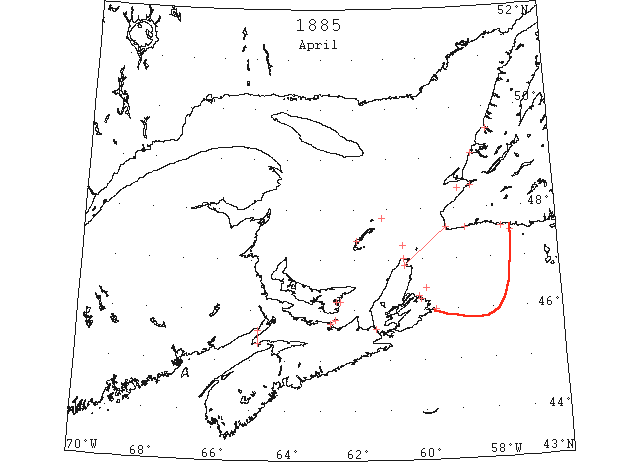
Apr There was much ice in the Gulf of St. Lawrence and along the Newfoundland coast, navigation in the Gulf being interrupted at the close of the month. (MWR Apr.p.88.1)
Apr 1 The roads in the country are becoming very soft. April begins springlike but the ice in the bays is still firm and fast. (Pat 1 Apr p3#1)
Apr 2 Northern ice departed Bonne Bay. (GR p.85)
Apr 2 Halifax, arrived, steamer “Newfoundland” from St. John’s, NF, reports passed through some broken pan ice. (MH 03/04/1885 p3 #6)
Apr 2 A dispatch today from Georgetown says there is no change in the condition of the ice outside that harbour. (Pat 2 Apr p3#1)
Apr 4 Northern ice departed Bay of Islands. (GR p.88)
Apr 5 Gulf ice departed Ramea. (GR p.97)
Apr 8 From E of the Banks to Sable Island, no date, a number of large icebergs and drift ice. (NYMR, p.3, col.1).
Apr 10 Coast blocked to Rose Blanche. (GR p.32)
Apr 11 Gulf ice departed Burgeo. (GR p.94)
Apr 16 Gulf ice departed St. George’s Bay. (GR p.91)
Apr 16 The schooner “Josephine” left Souris for Pictou on the 16th inst. The captain reports that he met with very little ice till he reached Pictou Island. Here he encountered a few clumpets through which he worked his way to Cariboo, a small island close to Pictou harbor. Capt. Cheverie says that there is no heavy ice in the gulf, and thinks that if the “Northern Light” had been got out of Georgetown she might have been making regular trips ever since the 5th of March last. (MH 24/04/1885 p3 #1)
Apr 17 Coast blocked to Rose Blanche. (GR p.32)
Apr 17 Schooner ” Ulrich R. Smith” arrived at St. John, NB and reported having encountered heavy ice off Cape Enrage and was obliged to put back; reports that as far as the eye could reach was seen a vast field of moving ice. (MWR).
Apr 19 No ice Cape Ray, Bay St. George full. (GR p.32)
Apr 19 The Newfoundland sealer “Young Prince” collided with a berg in the Gulf of St. Lawrence and sank almost immediately. (MWR)
Apr ~21 Meat Cove, CB, ice heavy close packed as far as can be seen, moving south. Low Point, heavy open, distant, moving off. (MH 21/04/1885 p3 #1)
Apr 21-26 Coast blocked. (GR p.32)
Apr 22 Magdalen Islands, ice, heavy and close packed, was moving west. Bird Rock reports do; moving south. Meat Cove, do, stationary; Low Point, do, moving south. (MH 23/04/1885 p3 #1)
Apr 23 Local ice cleared Bonne Bay. (GR p.85)
Apr 26 Local ice cleared St. George’s Bay. (GR p.91)
Apr 27 No ice Newfoundland side Cabot Strait. (GR p.32)
Apr 27 Mulgrave, NS, wind S E raining, and ice leaving. Magdalens and Bird Rock, ice heavy and close packed, moving north. Meat Cove, CB, ice heavy, open, distant. Low Point, CB, ice distant, moving ???? west. Canso, Diamond (returned reports left here yesterday for Newfoundland, met heavy, body of ice off Scatterie, and was obliged to return); 26th “P L [?]”, for Placentia, Nfld (met ice off Scatterie and returned). (MH 28/04/1885 p3 #5)
Apr 27 Lingan, CB, ice close packed and moving off. (MH 01/05/1885 p3 #5)
Apr ~27 Meat Cove, heavy close-packed ice stationary. Low Point, little ice east; no ice north. (MH 27/04/1885 p3 #5)
Apr 28 Amherst Island, MI., no ice in sight; other Magdalen Island stations state ice heavy close and packed moving south and E. Meat Cove, CB, reports the same. Low Point, CB, strong N W wind, ice distant, heavy and open, moving south very fast. (MH 29/04/1885 p3 #6)
Apr 29 SS “Brooklyn” from Liverpool to Quebec and Montreal arrived Halifax having to put back on account of heavy ice in the gulf. She got as far as Cape Ray. (MWR)
Apr 29 Halifax, arrived, steamer “Brockley” [“Brooklyn” cf. above] from Liverpool is bound to Montreal, but could not get up the Gulf on account of ice. (MH 30/04/1885 p3 #5)
Apr 30 SS “Miranda” passed 12 bergs between Cape Ray and Cape Pine. (MWR)
Apr 30 Magdalen Islands and Bird Rock, ice heavy and open; moving NW. Meat Cove, CB, no ice in sight. Low Point, CB, no ice in sight. (MH 01/05/1885 p3 #6)
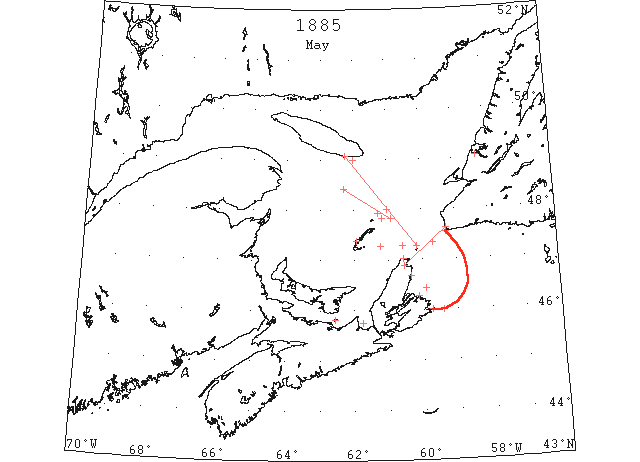
May “In May of both 1882 and 1885 much ice was observed in the Gulf of St. Lawrence, navigation being greatly impeded.” (MWR May 117.2)
May Large quantities of field ice have been encountered in the Gulf of St. Lawrence. [Chart shows a line of symbols from SE of Cape Ray to S of Anticosti] (PCNAO Jun 1885)
May 1 Local ice cleared out Bay of Islands. (GR p.88)
May 1 “New York” at Halifax reports passing enormous icebergs between Cape Ray and Cape Pine. (NYMR, 6 May p.2, col.5)
May 1 North Sydney, The schooner “Marie Adelle”, arrived to-day from St. John’s, Nfld. Reports encountered quantities of ice. Damaged bows slightly. (MH 02/05/1885 p3 #2)
May 1 Low Point, CB, ice distant, open and moving south. Bird Island, ice heavy and open, moving south. Magdalens, open ice distant and moving south. Meat Cove, ice heavy, open and distant, moving S.E. Low Point, CB, ice distant, open and moving south. (MH 02/05/1885 p3 #6)
May 2 Cabot Strait reported clear. (GR p.32)
May 2 The steamer “Princess of Wales” was delayed half an hour on her return trip from Pictou Saturday night, by ice in the Straits. (Pat 4 May p3#1)
May 4 SS “Polynesian” from Liverpool for Montreal and “Nestorian” from Glasgow to Montreal are reported to have returned to Cape Ray having found it impossible to get through the ice. (NYMR)
May 4 North Sydney, CB., All Magdalen Island stations report scattered ice moving south east. Meat Cove, CB, do; Low Point, CB, ice open inshore moving south. No ice outside. Passed 3rd , str “Scotland,” from London Quebec, met heavy ice. (MH 06/05/1885 p3#5)
May 4 The SS “Polynesian” and “Nestonian” are reported to have returned to Cape Ray on the 4th inst., having found it impossible to get through the ice. (MH 08/05/1885 p3 #3)
May 4 The “Miranda” from St. John’s passed twelve icebergs on the Newfoundland coast. (Pat 4 May p3#1)
May 4 A number of other vessels are fitting out and loading at the wharves here and now that the Gulf is clear will be leaving in a few days. (Pat 4 May p3#3)
May 5 Issue: Unusual number of immense icebergs in the North Atlantic Ocean and ice fields are also very extensive. Extensive ice also in the Gulf. (NYMR)
May 5 Low Point, CB, ice distant and open, moving south. (MH 06/05/1885 p3#5)
May 6 Steamer “Portia” (Br), at St. John’s, NF, from New York via Halifax, reported having passed several large icebergs. (NYMR 13 May p.3, col.2)
May 7 Amherst Island, no ice in sight; other Magdalen Island stations report light open ice distant. Bird Rock, heavy close packed ice moving south. Meat Cove, CB, heavy open ice everywhere, stationary. Low Point, CB, ice heavy; close packed inshore; moving south east, open water north east and west. (MH 08/05/1885 p3 #5)
May 8 Port Mulgrave, passed north, str “Nestorian” (Capt. knew ice up the gulf was all clear.) (MH 09/05/1885 p3 #6)
May 9 SS “Circassian” encountered field-ice in 47°50’N 60°54’W; cleared it on the 10th in 48°26’N 62°17’W. (MWR May 118.1)
May 9 Port Hood, CB, the Gulf of St. Lawrence is now free from ice as far as can be seen from here. ([MH?] 12/05/1885 p3#6)
May 10 “Quebec: From all accounts, the ice in the Gulf is unusually heavy, and blocks the usual Gulf route to this port.” (MWR May 118.1)
May 10 SS “Colina” encountered large quantities of field and straggling ice in the Gulf of St. Lawrence and remained fast for 9 hours, after which it got clear and proceeded on the voyage. (MWR May 120.1)
May 11 Nineteen Days On the Ice. A despatch from Port Hawkesbury says: The steamer “Cocoana,” from Boston for Sydney, reports ice at Scaterie. Could not get to Sydney. North Sydney, May 11 – The Norwegian steamer “Minerva,” from Glace Bay for Montreal, left Glace Bay Saturday morning, and at noon on the same day struck ice off Ingonish, damaging bows. She arrived here yesterday with bulk heads full of water. (MH 12/05/1885 p3 #5)
May ~11 The “Helvetia” arrived off Cape Ray about a week ago, and since then has been knocking about the ice in the Gulf, during which she got her bows stove and leaking badly. Unable to force her way up the gulf from Cape Ray, she headed for Sydney, intending to come round by the Strait of Canso, but when off Scaterie the leak increased very rapidly. The Allan liner “Acadian,” from Halifax for Sydney, was passing and was hailed by the distressed steamer. She took the “Helveita” in tow, and headed for Louisburg, but had only got a short distance when the captain of the “Helvetia” found his ship was sinking. There was barely time to get the passengers and crew on the “Acadian” when the “Helvetia” foundered. The “Acadian” then headed for the Strait of Canso, and landed the crew and passengers from the lost ship at Port Hawkesbury. An enormous quantity of ice is reported to be off Scaterie. (MH 11/05/1885 p3 #5)
May 12 SS “Ontario” passed several patches of field-ice from St. Paul Island to Anticosti; after this no more field ice was seen in the Gulf of St. Lawrence. (MWR May 118.2)
May 12 North Sydney: Despite the fact that the ice left our harbor over a fort night ago, our navigation has been impeded by the immense quantities of Artic [sic] and gulf ice which encircles our coast. The prevailing wind for the past ten days has been from the eastward and this drives the huge masses of floating crystal cakes on our shores, rendering ingress and egress from our harbors impossible for sailing vessels, and a source of danger to steamers, the iron hulls of which are entirely unfit to cope with the dangers of the ice fields. The Herald had already published the story of the foundering of the “Helvetia” and the narrow escape of the crew. The only other ‘lame duck’ in port is the Norwegian steamship “Minerva,” which sailed from Little Glace Bay on Friday last, bound for Montreal. This vessel encountered ice off Ingonish and damaged her bow, her fore compartments being full of water. Surveys have been held and the cargo will have to be discharged sufficiently to ascertain and repair the damage. The captain of the “Minerva” had his boats provisioned and ready to leave the ship, but fortunately the emergency was not so great. The steamship “Scotland,” which was quarantined here, is now coaling and will sail for Montreal. Several loaded vessels have been detained here for the past ten days. The winter has not been a severe one at all in Cape Breton, but the spring is very late and business is greatly retarded by the terrible state of the roads throughout the country and the difficulty of reaching us by sea. A large fleet of vessels is reported outside the ice making for our ports and the Gulf of St. Lawrence, but are hemmed in and retarded by the immense ice fields ‘so near and yet so far.’ From the mountain outlook at Cape North and from Magdalen Islands, special despatches for the Herald report that the ice light scattered and distant; and open at Bird Rocks, and moving south. This confirms previous ideas that the heavy ice had come down and has hung on our coast. But a day’s good westerly breeze will open our whole coast and render navigation perfectly open and our ports accessible. (MH 13/05/1885 p3 #3)
May 12 Magdalen Island, light scattered ice distant. Bird Rock, open moving south. Meat Cove, CB, light, scattered, distant. Low Point, south-east ice distant, open moving southeast. (MH 13/05/1885 p3#6)
May 13 SS “Suffolk” passed quantities of small ice to the NW of Bird Rocks. (MWR May 120.1)
May 13 Steamer “Polynesian” (Br), from Liverpool for Montreal, and “Nestorian” (Br), from Glasgow for Montreal are reported to have returned to Cape Ray on May 4th, having found it impossible to get through the ice. (NYMR, p.3, col.2)
May 15 Port Mulgrave, schooners could not get to Cape North for ice. (MH 16/05/1885 p3 #6)
May 18 Meat Cove, the schr “Ross,” of Halifax for Magdalen, struck the ice yesterday 20 miles off Entry Island and sunk. Crew saved. (MH 20/05/1885 p3#6)